Nara Period-2 (奈良時代‐2)
First following are four World Heritage sites in Nara left off
from previous post Nara Period-1;
最初に前回積み残した、奈良の世界遺産8か所の、後半4か所の説明です。
Yakushiji;
Head temple of Hosso sect. Temmu Emperor built praying
ill recovery of Jito Empress in 680. Moved to present place
of west-kyo in early 8th century. East tower is of Nara
Period showing beauty of Tenpyo culture. On top of the
east tower, Toindo, Yakushi triad of Kindo and so forth are
National Treasures. In Genjyo-Sanoin built in 1991, the
Datang Western regions mural Ikuo Hirayama spent 30 years
to complete is exhibited. Koin Takada (1924-1998) is
renowned by his lifework of lectures and solicitation through
out Japan to rebuild Kindo, West-Tower etcetra,
薬師寺;
法相宗の本山、天武天皇創建(680年)、後の持統天皇の皇后の病気
平癒を祈願して建て、8世紀初頃現在の西京の地に移転。国宝の東塔
は唯一奈良天平年間のもの。東院堂や金堂の三尊像等国宝も多数。
1991年建立の玄奘三蔵院には平山郁夫が30年かけた大唐西域壁画が
展示されている。高田好胤が講演等の勧進で金堂・西塔等の再建を
推進したことも近年の出来事として知られている。
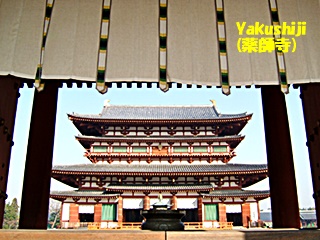
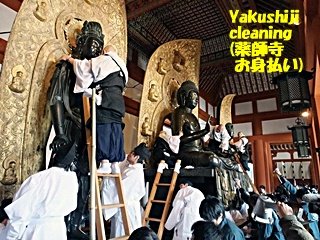
Tosyodaiji;
Head temple of Rissyu, built in 759 by Ganjin Wajo(JianZhen).
Ganjin Wajo finally came to Japan in 754 after 6 extremely hard
voyages causing his sight loss, in response to the invitation
as the guru in 742. He bestowed commandment to Shomu Emperor,
Komyo Empress, Koken Emperor and many monks at Todaiji.
First 5 years, he was at todaiji, and after 759, he lived in
Tosyodaiji. Kindo, Kodo (lecture hall), and etcetra are National
Treasures as well as the Seated figure of Ganjin Wajo.
Every year, on June 5th to 7th, Mieido (Memory hall of founder)
opens for public and the Seated Figure is exhibited as well as
wall paintings of Kaii Higashiyama.
唐招提寺;
律宗総本山で759年鑑真和上が創建。鑑真和上は742年に導師として
の来日要請に応え、6回の苦難の船旅で視力を失いながらも、754年
に漸く来日、東大寺で聖武太上天皇・光明皇后・孝謙天皇等に戒を
授けた。最初の5年は東大寺、759年から五年間は唐招提寺に住んだ。
金堂・講堂等の伽藍や鑑真和上の座像も国宝となっている。
年中行事として鑑真和上の命日の6月5日~7日に御影堂で和上座像と
東山魁夷の障壁画が公開される。
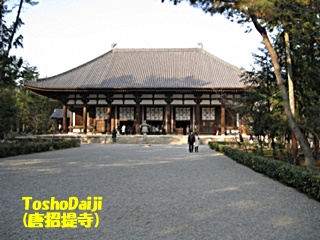
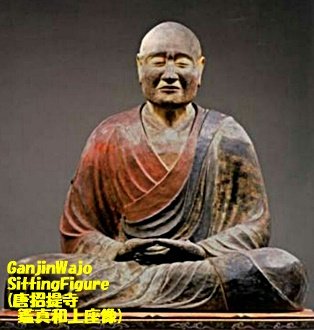
HeijoGuAto;
As already mentioned, in 2010, to commemorate the trasnfer of
Heijo-Kyo from Fujiwara-Kyo, the replica of DaiGokuDen (Council
hall) was built and the site was named "HeijoKyuAto Histrical
Park". Other buildings as the Imperial Palace, TyodoIn(Ceremony
Hall), 12 Gates are planned to add in addition to the Eastern
Garden which is considered as the prototype of Japanese garden.
To walk from Suzaku Gate to DaiKyokuDen, there is a railroad
crossing where trains frequently pass and people need to wait.
It is not only inconvenient but quite awkuard and pooper to see
modern machines in an ancient mood.
平城宮跡;
平城京の北端の内裏と朝堂院、役人が執務を行う外朝から成り、
朱雀門等12の門、東端には東院庭園(日本の庭園の原型)があった。
2010年前述通り、遷都1300年を記念して、大極殿が建てられ、その後
平城宮跡歴史公園となっている。朱雀門から大極殿の間は徒歩で
歩くが、途中に電車が結構頻繁に通り、踏切で待たされるが、”あおに
よし”の古代の雰囲気を楽しもうという気分には、何とも興ざめである。
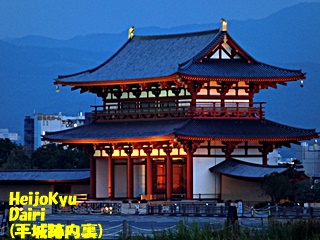
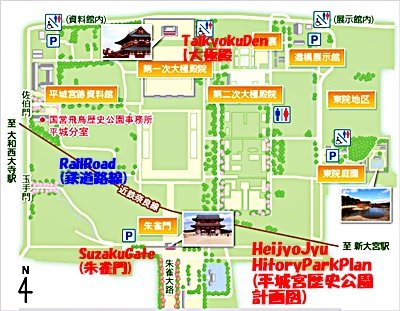
Kasugaya Genseirin;
Eastern mountain area of Sanctuary of Kasuga Shrine.
Since 841, hunting and cutting down trees have been prohibited
resulting quite unique primeval condition which is good for
environment of surrounding area, though near city area, and
recognized and designated as one of World Heritage site in Nara.
Trees of south temperate zone are many, actively breeding and
ivy type plants grow a lot. This laurel forest is also designated
as one of national scenic spot. To walk the corse including
this forest and Wakakusa mountain starting Kasuga Shrine is about
100 minutes.
春日山原始林;
奈良市の東方で、春日神社の神域とされ、841年来狩猟・樹木伐採
禁止で、原始性が保たれて、周辺の環境保全にも資し、世界遺産にも
指定されている。暖帯南部の樹木が多く、繁殖も盛んで蔦性植物も
多く、市街地に近い場所では珍しく、この照葉樹林は国の名勝にも
指定されている。春日大社から、遊歩道ー若草山経由等のコースで
1時間半程度で歩ける。
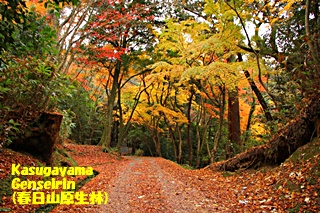
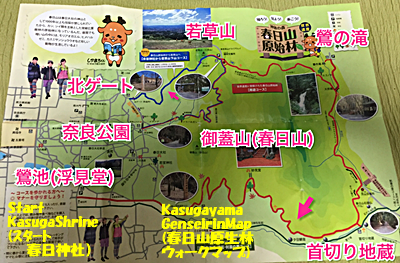
Before leaving Nara Park area, I must add one more important subject in this
area, "ShoSoIn" used to be the warehouse of Todaiji, keeping treasures of Nara
Peeiod.
奈良公園地域を離れる前に、もう一つ触れておきたい所があります
それは、東大寺の宝物を保存する”正倉院”と毎年その展示を続けている、
国立博物館です。
At first,in 756 Koumyou Empress concecrated some 650 pieces of treasures
bequested by Shomu Emperor at his 17 death anniversary, to Daibutsu of
Todaiji adding several times of similar consecrations. Therefore major
portion of its treasures is either of Shomu Emperor or Koumyo Empress,
including not only japanese makes but products of China, Western Region,
and even from Percia, causing ShoSoIn referred to as "Eastern Terminal of
Silkroad". Treasures also include rare and important documents to exactly
know affairs in Nara Period like ShoSoIn documents or records of Buddha Eye-
Opening Ceremony and so forth. Administration of treasures was transferred
to Imperial Household Agency in 1884.
Original warehouse is made of cypress tree materials in stilts and log house
style. Treasures have been kept in coffins and open/close of doors have been
strictly under control of "ChokuFuu" meaning Emperor's authorization required.
The structure of warehouse and severe control of keeping treasure system
probably helped to protect treasures in good condition for long years.
Some 9000 treasures have been arranged and listed, some 3300 can be seen by
photos at the homepage of Imperial Household Agency. Every year, they hold
"ShoSoIn-Ten" exhibition at Nara National Museum in fall season for two weeks
though treasures displayed are only 70 pieces or so and the time of exhibition
is not fixed, therefore you have to watch the date in advance.
The original "ShoSoIn" warehouse can be observed though from outside only, on
weekday from 10 am to 3 pm free without any application.
正倉院;
756年光明皇后が聖武天皇の17回忌に天皇の遺愛の品約650点
を大仏に奉献したのが始まりて、その後も皇后は三度に亘り
自身や天皇縁の品々を大仏に献納して、現在の正倉院宝物の
中心となっている。 元は東大寺の蔵だったが、1884年に
宮内庁管轄となった。 日本製品だけでなく、中国や西域・
ペルシャからの美術品等も多く、また奈良時代を知る上で
貴重な正倉院文書、東大寺大仏開眼法要関係の品、古代の
薬品等も保存される文化財の一大宝庫で、シルクロードの
東の終点とも言われている。
奈良国立博物館で毎年秋に”正倉院展”が開かれるが、それ
以外の時期に宝物を見る機会はない。 宮内庁管轄の宝物で
整理済みのものだけで約9000点あり、毎年の正倉院展は約
70点程度の展示なので、ほんの一部ということになる。
(宮内庁が約三分の一の3300点の宝物の写真をホームページ
で見れるようにしており、年々その枚数を増やしています)
正倉院展は毎年2週間程度の開催期間で、期日は未定なので
予定を確認して行く必要がある。尚正倉院は本来は檜で高床
式、校倉・板倉作りで、内部の宝物は辛櫃に収められ、且つ
開閉は勅封で、厳重に管理され、長年宝物を守っています。
現在はそれ以外にコンクリート造りの東西宝庫が出来ており、
主な宝物は両宝庫で管理されている。本来の校倉作りの
正倉院は外部からのみですが、見学出来ます(土日祝日以外
10時~3時)
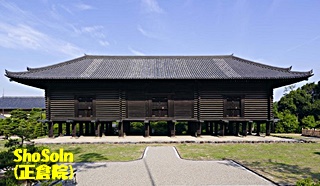
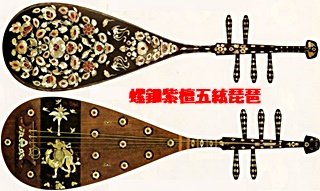
フォローさせていただきました!
観光する時、参考にしたいと思います^^
有難う御座います、参考になれば幸いです。 geohase
奈良時代は、比較的注目されにくいと思います。参考にさせていただきます。
有難う御座います、参考になれば幸いです。 geohase